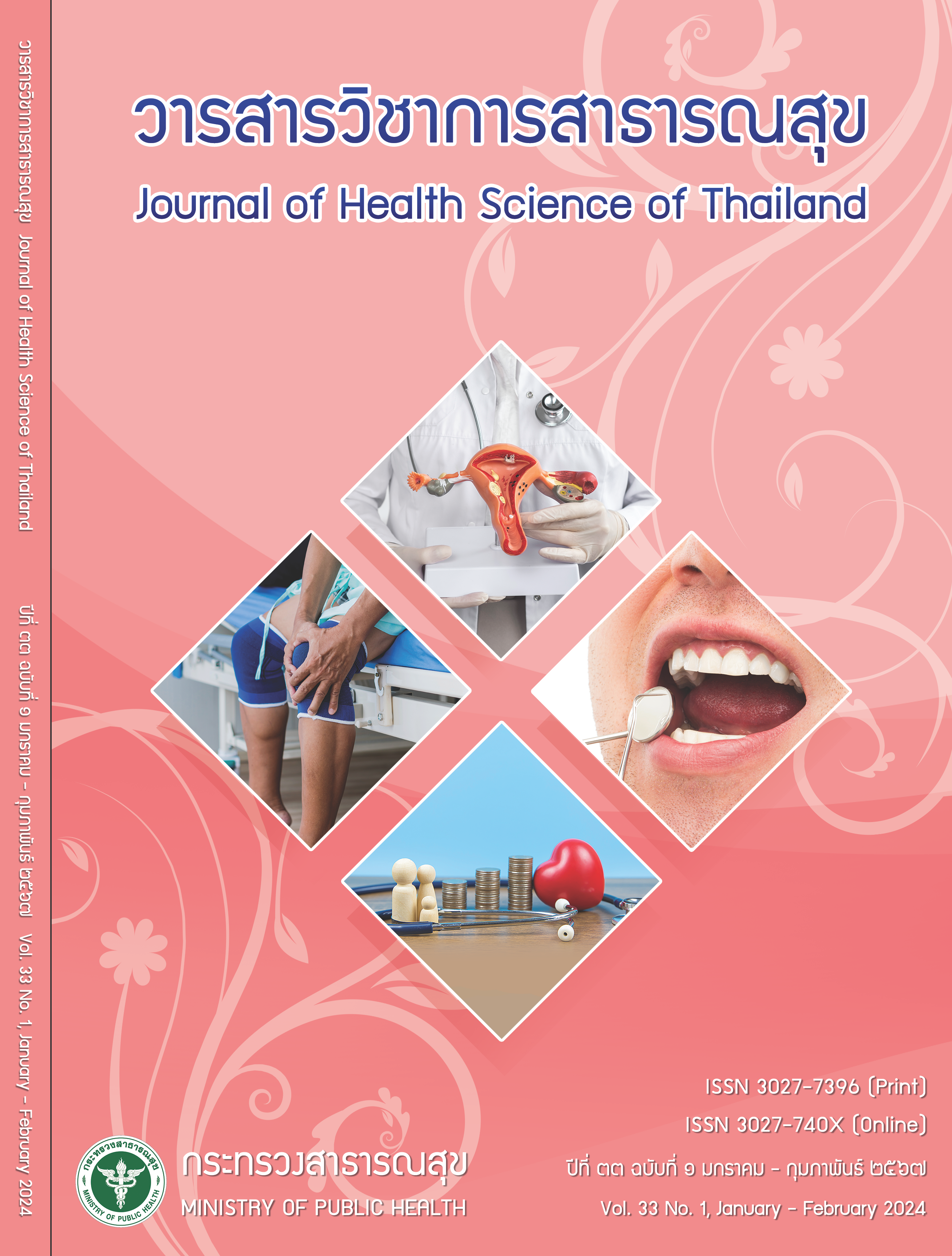Gender Factor on Mortality Risk among COVID-19 Patients Admitted in Samutprakan Hospital
Keywords:
Covid-19, mortality of covid-19, gender affecting mortality, underlying diseasesAbstract
This retrospective study aimed to identify factors affecting the mortality of patients with COVID-19 in Samutprakan Hospital from January 2020 to September 2022. The data were reviewed from the coronavirus-19 report of the Ministry of Public Health and medical records. Descriptive statistics and Chisquare tests were used for data analysis. The results were presented as an adjusted odds ratio with a 95% confidence interval. This study revealed that deaths with covid-19 patients were 689 cases. There were 1.2 times more males than females with the average age of 72.5 years old (range from 9 months to 102 years old). The comorbidities were found including hypertension (70.0%), diabetes (44.9%), chronic kidney disease stage 3 or more (25.0%), and bed-ridden status (15.8%). The average duration of illness and length of stay were 2.2 and 9.7 days, respectively. Eighty-four percent of COVID-19 death patients were not vaccinated. More than half of the patients had been treated using high-pressure oxygen levels. The most common complications causing death included acute renal failure, atrial fibrillation and upper gastrointestinal bleeding. Neutrophil to lymphocyte ratio >3.13 was found in 62.8% of death patients which was a predictor to develop critical illness. The potential risk factors which were statistically significantly associated with COVID-19 mortality included diabetes, hypertension, CKD stage 3 or more, cerebrovascular disease, pulmonary disease, chronic liver disease and malignancy in males and BMI more than 30 Kg/m2 and bed-ridden status in females.
Downloads
References
กรมควบคุมโรค. โรคติดเชื้อไวรัสโคโรน่า2019 (COVID19) สถานการณ์ในประเทศไทย [อินเทอร์เน็ต]. 2565 [สืบค้นเมื่อเมื่อ 1 ต.ค. 2565]. แหล่งข้อมูล: https://ddc. moph.go.th/viralpneumonia/
Bai Y, Yao L, Wei T, Tian F, Jin DY, Chen L, et al. Psesumed Asymptomatic Carrier Transmission of COVID-19 . JAMA 2020;323(14):1406-7.
Lai CC, Liu YH, Wang CY, Wang YH, Hsueh SC, Yen MY, et al. Asymptomatic carrier state, acute respiratory disease, and pneumonia due to severe acute respiratory syndrome coronavirus 2 (SARS-CoV-2): Facts and myths. J Microbiol Immunol Infect 2020;53(3):404- 12.
Wu F, Zhao S, Yu B, Chen YM, Wang W, Song ZG, et al. A new coronavirus associated with human respiratory disease in China, Nature 2020;579(7798):265-9.
Eaaswarkhanth M, Al Madhoun A, Al-Mulla F. Could the D614G substitution in the SARS-CoV-2 spike (S) protein be associated with higher COVID-19 mortality?. Int J Infect Dis 2020;96:459-70.
Wang D, Hu B, Hu C, Zhu F, Liu X, Zhang J, et al. Clinical characteristics of 138 hospitalized patients with 2019 novel coronavirus-infected pneumonia in Wuhan, China. JAMA 2020;323(11):1061-9.
Alahmad B, Al-Shammari AA, Bennakhi A, Al-Mulla F, Ali H. Fasting blood glucose and COVID-19 severity: nonlinearity matters. Diabetes Care 2020; 43(12):3113-16.
Forget P, Khalifa C, Defour JP, Latinne D, Van Pel MC, De Kock M. What is the normal value of the neutrophil-to-lymphocyte ratio? BMC Res Notes 2017;10(1): 12.
Areerattanavet K, Keawkangsadan V, Asanprakit W, Satthaporn S, Vassanasiri W. Evaluation of pre-treatment neutrophil to lymphocyte ratio (NLR) in prediction of disease free survival (DFS) in patients with operable breast cancers. Royal Thai Army Medical Journal 2017;70(3):119-26.
Thaenkaew S, Wongkham S. Application of using blood neutrophil to lymphocyte ratio for prognosis. Srinagrarind Med J 2016;31(5)332-38.
Ethier JL, Desaultels D, Templeton A, Shah Ps, Amir E. Prognostic role of neutrophil-to-lymphocyte ratio in breast cancer: a systematic review and meta-analysis. Breast Cancer Research 2017;19(2):2.
Liu J, Liu Y, Xiang P, Pu L, Xiong H, Li C, et al. Neutrophil-to-lymphocyte ratio predicts critical illness patients with 2019 coronavirus disease in the early stage. J Transl Med 2020;18:206-17.
Al-Mazedi MY, Rajan R, Al-Jarallah M, Dashti R, Al-Saber A, Pan J, et al. Neutrophil-to-lymphocyteratio and in-hospital mortality among patients with SARS-CoV-2: a retrospective study. Annals of Medicine and Surgery 2022; 82:104748.
Prozan L, Shusterman E, Ablin J, Mitelpunkt A, Weiss-Meilik A, Adler A, et al. Prognostic value of neutrophil-to-lymphocyte ratio in COVID-19 compared with Influenza and respiratory syncytial virus infection. Nature 2021;11:927-34.
กระทรวงสาธารณสุข. สรุปผลดำเนินงานตัวชี้วัดปี 2565 ลำดับที่ 27 อัตราป่ วยตายของผู้ป่ วยโรคติดเชื้อไวรัสโคโรนา 2019 (COVID-19) ของทั้งประเทศ [อินเทอร์เน็ต]. 2565 [สืบค้นเมื่อ 1 มี.ค. 2566]. แหล่งข้อมูล: http://healthkpi. moph.go.th/kpi2/kpi/index/?id=1915&k-pi_year
Martins-Filho PR, Souza Araújo AA, Pereira LX, Quintans-Júnior LJ, Souza Barboza W, Cavalcante TF, et al. Factors associated with mortality among hospitalized patients with COVID-19: a retrospective cohort study. Am J Trop Med Hyg 2021;104(1):103-5.
Pan F, Yang L, Li Y, Liang B, Li L, Ye T, et al . Factors associated with death outcome in patients with severe coronavirus disease-19 (COVID-19): a case-control study. Int J Med Sci 2020;17:1281-92.
da Costa Sousa V, da Silva MC, de Mello MP, Guimarães JAM, Perini JA. Factors associated with mortality, length of hospital stay and diagnosis of COVID-19: data from a field hospital. Journal of Infection and Public Health 2022;15(7):800-5.
Downloads
Published
How to Cite
Issue
Section
License
Copyright (c) 2024 Ministry of Public Health

This work is licensed under a Creative Commons Attribution-NonCommercial-NoDerivatives 4.0 International License.







